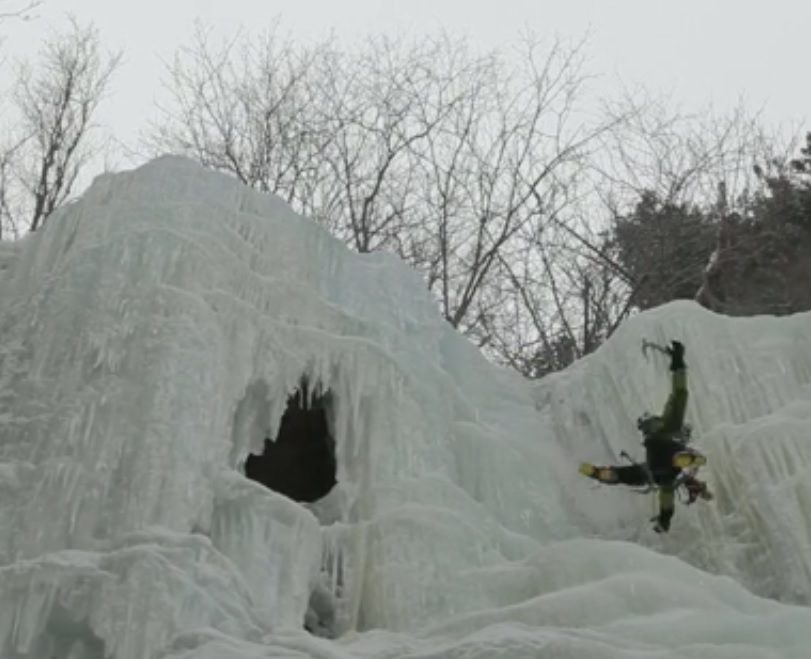Big Ice Climbing Whipper and Seasonal Reminders
A few things to keep in mind when heading out ice climbing this winter

It’s ice climbing season in Canada and for many that means transitioning from rock to swinging tools. In the video below, a climber takes a lead fall on Dracula WI4+ in New Hampshire after getting too pumped to put in a screw.
Head to 3:28 to watch the accident (no obvious trauma or blood). The videographer wrote about the experience here.
In 2011, Will Gadd wrote a blog called Ice Climbing is Not Rock Climbing. Every word of it applies to today. He said in the article, “I don’t mean this to be harsh to the individual climbers at all, with any luck I will have caused some thinking among a much wider readership as these errors are way too common, these guys just made a video.” In it, he picks apart the above film and offers advice on what to do differently.
“One of the biggest problems I see in ice climbing starts with people approaching ice climbing like they do rock climbing,” said Gadd. “That mindset is totally inappropriate, and leads to really avoidable accidents.”
You can head over and read the article here, below are a few highlights to keep in mind.
Reminder: Always put the belay out of the fall-line for incoming ice. Almost all ice climbs have safe-enough areas to do this. If you’re a by-stander waiting to climb next, don’t stand under falling ice.
Reminder: Avoid falling off ice. Clip into your tool or a screw, but don’t fall. “The first and biggest error in the thinking of the climbers is expressed at the end of the film when the belayer says at 14:20, ‘Falling is very common, it should be expected.'” said Gadd. “No, it isn’t.”
Reminder: Don’t lead if you’re not good at ice climbing. Do top-rope laps until you have the technique and power down to lead and place protection.
Reminder: Just because the protection is lighter and easier to put in doesn’t mean you should be whipping onto it. A climber in the video said, “Yeah, I have great faith in the equipment now, and it gives me even more reason to put pro in.” Gadd notes, “This is just wrong on so many levels, but first of all it misses the entire point that ice climbing isn’t about the pro, it’s about first not falling off.”
Reminder: Rock pumps are different than ice pumps. “In rock climbing it’s often OK to climb deep into a pump, even to the point of falling,” said Gadd. “In fact, that’s often the point in rock climbing. It is not OK to climb super-pumped on ice, the consequences of a fall are simply too high… If you’re super pumped stop, reset. No ‘free’ pitch is worth getting injured for.”
Reminder: Don’t lower climbers onto their heads. “If I fall off like that please don’t lower me head-first back toward the ground,” said Gadd. “The climber’s legs go over his head at about 9:50. Again, it’s an intense situation, but I’d suspect a possible spinal injury with that much force and speed.”
Reminder: While the climb in the video is not a multi-pitch, it’s important to remember that you shouldn’t climb under other parties on ice. You’re putting yourself in harms way when you head up the fall-line of ice and gear.
Why falling on ice is worse than rock: Crampons tend to catch on the ice and result in broken ankles and legs and lead to the climber flipping. Ice climbs are often more run-out than rock climbs.
Ice climbs are usually less steep than rock which leads to ledge landings. Due to temperatures, day light and remoteness, ice climbs have higher commitment factors. You have sharp crampons, ice tools and screws that can puncture you. For 12 ways to not fall while ice climbing visit here.
In 2015, the climber in the video who took the fall wrote to Gadd: “Thanks again for the conversations with me about this.
“I am here almost five years later, thankful that I am okay. I learned much from you and the community. I take to heart the comments from the genuinely interested and those who are humble enough to learn. Climb on. From Nate, the guy in the video in the green jacket.”


